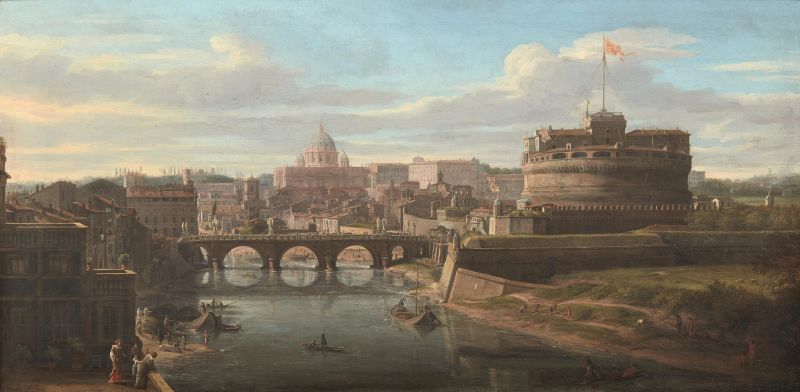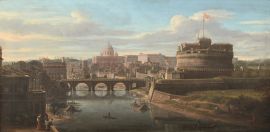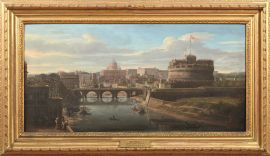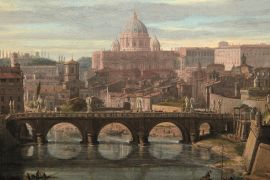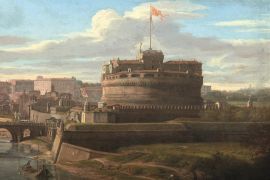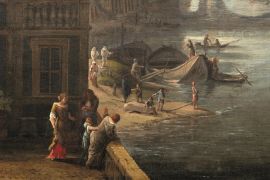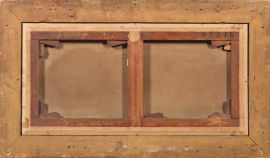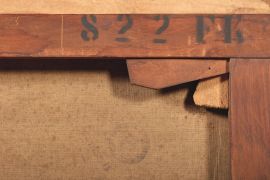Gaspar van Wittel (Gaspare Vanvitelli)
Gaspar van Wittel (Gaspare Vanvitelli)
(Amersfoort (Utrecht) 1652/53 – Rome 1736)
A VIEW OF THE TIBER WITH CASTEL SANT’ANGELO AND THE VATICAN
oil on canvas, cm 49x98,5
An export license is available for this lot.
Provenance
H.R.H the Princess Royal Louise, Duchess of Fife (1867-1931); Christie’s, London, 18 December 1931; in the collection of the present owner since 1960s.
Literature
“Catalogue of Ancient and Modern Pictures the property of H.R.H. the late Princess Royal removed from 15, Portman Square, W1. Now sold by direction of Lady Maud Carnegie”. Christie’s, London, 18 December 1931, p. 23, n. 134: “a view of Rome from the Tiber”; G. Briganti, “Gaspar van Wittel”. A new edition edited by Laura Laureati and Ludovica Trezzani, Milan 1996, p. 181, n. 133.
As an iconic image of the Eternal City created by Gaspar van Wittel for his Grand Tour clientèle, this magnificent view of Rome shows some of the most important historical buildings from the classic past of the city and its Christian present, as well as everyday scenes occurring on the Tiber banks among its present-time dwellers.
The view was taken from a vantage point close to Tor di Nona on the left side of the river; its dominant feature is the circular volume of the Castel Sant’Angelo, the papal fortress having as its core emperor Hadrian’s mausoleum, around which towers and bastions were built in the sixteenth and seventeenth centuries. In the background, the Vatican basilica and palace may be seen; in the centre, ponte Sant’Angelo, recently decorated with sculptures by Gian Lorenzo Bernini and his school (1669-1671) spans the river in lieu of the antique pons Aelius built in Hadrian’s time.
Minor buildings on both sides of the river are equally interesting to the modern eye, as a testament to a partly destroyed cityscape due to the construction of the so-called Lungotevere, the modern embankment from the end of XIX century. On the left bank we can thus recognize palazzo Altoviti, no longer extant, its sixteenth century façade opening on the square facing the bridge. In the middle distance, on the right bank, is the hospital of Santo Spirito in Saxia and the church in the same name with its distinctive hexagonal bell-tower. Further right, minor buildings of the so-called Borghi may be seen; they were destroyed in the 1930s when via della Conciliazione leading to the Vatican was opened up.
Although appearing in the preparatory study to this view (see infra) and in all painted versions, the terrace in the foreground seems a phantasy feature created by Gaspar van Wittel as a perspective and compositional device, as the building portrayed appears too sophisticated for the popular district of Tor di Nona.
On the small beach close to the so-called arco di Parma on the left, and at the “prati di Castello” on the opposite side, the river banks are crowded with fishers and bathers, and people watching the small craft on the river. On the left, two women lean from the terrace out of curiosity for everyday happenings.
This view of the Tiber was certainly the most successful among the many river subjects by Gaspar van Wittel; it was especially sought after by his Italian patrons as well as by Grand Tourists travelling to Rome and wishing to buy a highly symbolic souvenir of the city, at the time the most visited in Europe. Eleven autograph versions of this view, including the present painting, are currently known (see “Gaspar van Wittel”. New edition curated by Laura Laureati and Ludovica Trezzani, Milan 1996, pp. 178-181, nn. 126-136), and two more are still unpublished.
They were painted through the artist’s entire career, and bear dates from 1682 to 1722. The first version is the tempera painting in the Capitoline Museum, Rome, from the collection of Marchese Sacchetti, who was Van Wittel’s first patron in the early 1680s. A tempera in Galleria Nazionale d’Arte Antica, Rome, comes next, from a set of four in Livio Odescalchi collection, as documented by his 1713 inventory. The whole series bears on the verso autograph inscriptions in Dutch, the language Van Wittel used consistently for his working notes. A tempera version from 1689 probably comes from the Colonna collection, where another tempera from 1722 remains to this day.
During the 1690s and in the first two decades of the XVIII century Van Wittel painted this subject in oils over increasingly wide canvases, the largest now in Rouen, Musée des Beaux Arts. They all match each other in the main features, the only difference being a wider section of the Prati di Castello on the right of the veduta (see the catalogue of the exhibition “Gaspare Vanvitelli e le origini del vedutismo”, Roma 2002, pp. 128-131, nn. 28 e 29). Our painting, probably from the early XVIII century, belongs to the latter group.
All painted versions were made after the large preparatory drawing (mm 237x480) now in the Biblioteca Nazionale Centrale Vittorio Emanuele, Rome (Disegni 3, III, 18), one of the very important group of preparatory studies by Van Wittel relating to views of Rome, Florence, Naples and Venice.
Having been used for so many paintings in oils and tempera, its condition is unfortunately poor, if compared to drawings related to less successful subjects and therefore seldom used, possibly for only one painting. Among them, the view of the Tiber between the Castle’s bastions, or the enchanting view with the church of S. Giovanni dei Fiorentini, quite close to our location.
Gaspar van Wittel was the first veduta painting in Italy, and the first artist painting this subject, which was repeated in etching and in oils throughout the XVIII and XIX centuries. Among Van Wittel’s early followers, Giuseppe Vasi and Antonio Joli should at least be mentioned.
Coming from the collection of the Princess Royal Louise, daughter to King Edward VII, our painting was auctioned by Christie’s in 1931 as a work by Gaspare Vanvitelli. The attribution was confirmed by Professor Giuliano Briganti to the family of the current owner; it was included in Van Wittel’s general catalogue curated by Laura Laureati and Ludovica Trezzani in 1996.
Biography
Gaspar van Wittel trained as a topographer in the workshop of Matthias Withoos. He left his homeland for Italy in 1674, and is first documented in Rome in January 1675, having probably stopped in Venice in his south-bound trip from Holland.
Having worked as a topography draughtsman for the Dutch engineer Cornelis Meyer, in 1680 he painted his first views of Rome, small temperas portraying Piazza del Popolo. In the next few years he drew most of his Roman subjects, showing the modern layout of the city as well as its ancient ruins, its more recent secular and ecclesiastical buildings in newly-designed piazzas, and the winding course of the Tiber within busy or solitary banks. He soon graduated from tempera to oil painting and to ever-increasing formats, always working from the preparatory drawings now in Biblioteca Nazionale Centrale Vittorio Emanuele, Rome.
In 1690 Van Wittel took his first trip North, documented by a view of the Borromee Islands on Lago Maggiore; in 1694-95 a longer trip took him to Venice, by way of Florence (where he stopped for a few months working for the Medici court) and Bologna. In 1699 he moved to Naples at the invitation of the Spanish Vice-Roy, the Duke of Medinaceli, formerly the Spanish ambassador in Rome and brother in law of Prince Filippo II Colonna, Van Wittel’s major patron. He was back in Rome in 1702, having painted for Duke Medinaceli his first and most celebrated views of Naples, among them the Darsena, a favourite subject among his clients, both Roman and foreign.
Van Wittel’s Italian views and his fantasy landscapes in the manner of Claude Lorrain were much sought-after by distinguished foreign visitors, mostly British and French, coming to Italy for their education. Among the artist’s early patrons, Thomas Coke (1697-1759), later Earl of Leicester, and Richard Boyle (1694-1753), Lord Burlington, should be mentioned, the former acquiring on his Grand Tour and later no less than fifteen works by Van Wittel in oil, tempera and wash, some of them directly from the artist in 1716-17, the latter buying in 1714 twelve ink and wash drawings, with oil paintings entering his collection in the 1720s through the painter and dealer Andrew Hay, whose sales helped disseminate Vanvitelli’s work in Great Britain.
Working for Grand-Tourists and foreign collectors helped Van Wittel define the range of his subjects. He concentrated in fact on the more iconic views of Rome ancient and modern, of Naples and Venice, and left aside views of less well- known and scarcely visited places, which were hardly on demand. A few of them are in fact extremely modern in their outlook of minor aspects of 18th century Italy, and therefore quite appealing to the modern eye.

